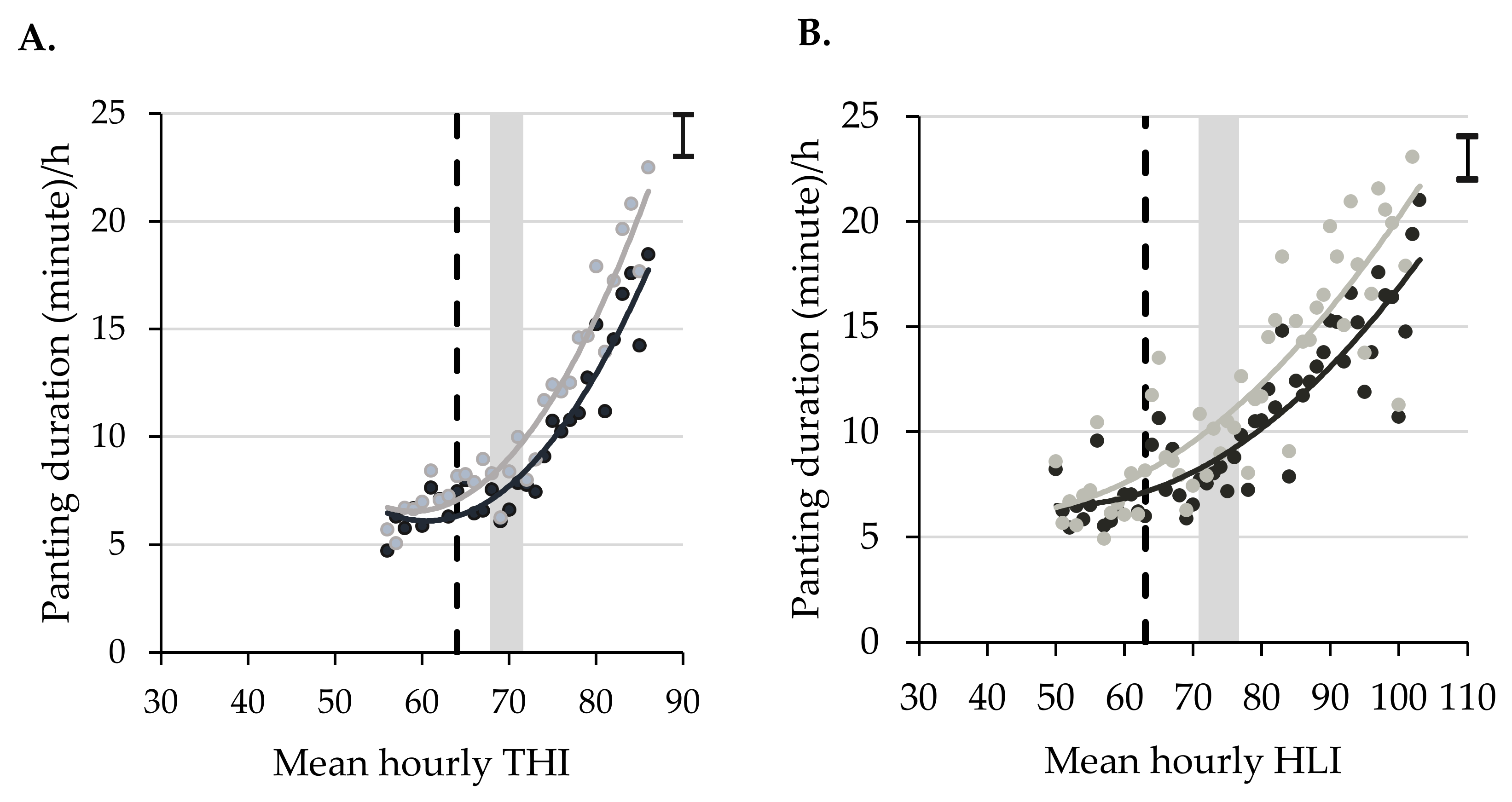1. Introduction
Heat stress is “the sum of external forces acting on an animal that causes an increase in body temperature and evokes a physiological response” [
1] or the “imbalance between metabolic heat production inside the animal body and its dissipation to the surroundings under high air temperature and humid climates” [
2]. The degree of heat stress depends on animal factors including genotype, coat colour, coat type, sex, body condition, health, physiological and metabolic condition; and environmental factors including temperature, humidity, solar radiation, wind speed, cloud cover, rainfall, and management [
3]. Heat stress is associated with significant economic loss [
4,
5,
6,
7,
8] in the cattle industry, compromised production [
5,
9,
10,
11] and welfare [
12,
13] and in extreme cases, a greater incidence of mortality [
4,
14]. In addition, ameliorating heat can require a significant amount of infrastructure, labour, and energy [
7].
Heat stress has been traditionally monitored using the visual assessment of an animal’s response evoked by high ambient temperatures and 25 °C has been suggested as a threshold after which both dairy [
15] and beef [
16] cattle experience heat stress. However, a threshold of 22 °C [
17] has also been suggested for feedlot cattle. Cattle, similar to other homeothermic animals, attempt to maintain a constant body temperature of approximately 38–39 °C [
18,
19,
20]) by dissipating heat produced in the body into the surrounding environment through conduction, convection, evaporation, and radiation [
21,
22]. Non-evaporative heat dissipation mechanisms become less effective, and animals depend more on evaporative heat dissipation, when ambient temperatures rise to 29–32 °C and approach, or exceed, skin surface temperature (approximately 37 °C) [
23,
24]. However, evaporative heat dissipation can be increased significantly at temperature as low as 18.3 °C [
22]. Evaporative heat dissipation is achieved in part by sweating and further by increased respiration rate with characteristic shifts in respiratory dynamics (measured as panting scores [
17,
18,
25,
26]), whereby body heat is released as latent heat of vapourisation of moisture from the skin surface and respiratory tract mucosa [
24,
27,
28]. As such, monitoring respiration rate has become a reliable animal response indicator of heat stress [
4,
29]. However, visual recording of respiration rate is impractical under commercial and field conditions [
30]. The inadequacy of ambient temperature as a single measure to represent the thermal condition of cattle has led to the development of numerous thermal indices such as the temperature humidity index, THI; black globe humidity index, BGHI; environmental stress index, ESI; skin surface temperature humidity index, STHI; respiratory rate predictor, PRR; heat load index, HLI; and the accumulated heat load unit, AHLU as measures of the impact of heat on the animal [
25,
26,
31,
32].
The temperature humidity index, combining both air temperature and relative humidity, was developed based on Thom’s discomfort index for humans [
33] and has been widely used in livestock since the 1960s with its limitations related to wind speed and solar radiation [
26,
34]. Latter indices such as ESI combining air temperature, relative humidity, and solar radiation and HLI combining relative humidity, wind speed, and black globe temperature accounted for both environmental stressors and physiologic response, which were modified for animal and management factors. These latter indices are better correlated with the respiration rate and rectal temperature of cattle as compared with THI [
32]. The HLI is currently used by the Australian feedlot industry and was developed with reference to panting score, which is a robust indicator of heat stress at a herd or pen level [
17,
35,
36]. Panting scores range between 0 and 4.5 and are assigned on the basis of severity of panting, presence or absence of drool, open mouth, and extended tongue [
25]. The robustness of HLI is due to the inclusion of several environmental (black globe temperature accounting for ambient temperature and solar radiation, humidity, and wind speed), management (cooling effect, manure pad status, days on feed and drinking water temperature) and animal factors (genotype, coat colour, and health status) associated with heat load [
25]. Despite its robustness, HLI does not represent the accumulated effects of heat exposure and the heat stress level of individual cattle. The adjustment of HLI thresholds based on animal factors and the combination of intensity and duration of heat exposure in the form of AHLU is now practiced for a better assessment of thermal condition at the group level. However, microclimatic variations between locations of the pen, compared to the location of the weather station, may affect the assessment of thermal condition at the individual level. To determine the impact of heat load on the individual animal across time, and for the strategic mitigation of cattle heat stress at an individual level, automated monitoring of the real-time animal response to heat stress is required. Commercially available accelerometer-based sensors (HR-LDn; SCR Engineers Ltd., Netanya, Israel) monitor the behaviour of cattle [
37,
38], including ‘heavy breathing’ (referred to as ‘panting’ in the latter sections), as defined by forward–backward heaving with an increased rate of respiration and thoracic wall extension [
39]. Accelerometer-based ear tag sensors have been previously validated to monitor cattle behaviour and provide a promising tool for the automated monitoring of eating, ruminating, and resting behaviours [
40,
41,
42]. However, ear tag sensors require validation to monitor and quantify heat stress-related panting behaviour and individual variability.
The degree of heat stress varies with genotype and coat colour, with
Bos taurus, dark coloured (black and red) and high coat scored cattle less heat tolerant than
Bos indicus, light coloured and low coat score cattle [
21,
23,
43,
44]. As oppose to the common belief that
Bos indicus cattle do not need heat load alleviation measures, Brahman cattle have been found to increase shade utilisation by 27% between 0800 and 1200 h [
45]; however, the variability between cattle within genotype or coat categories is less known. Continuous and long-term monitoring is required to quantify individual variability in heat stress responses for more specific mitigation decisions and for improved genetic selection for heat resilience. Our objectives were to (i) validate an accelerometer-based ear tag sensor for cattle panting, (ii) determine the variability in panting duration between cattle breeds and individuals, and (iii) compare thermal indices against sensor-derived panting at an individual animal level.
4. Discussion
Our work highlights the ability to accurately and autonomously reveal the temporal and spatial variability of individual cattle PS through time. In Experiment 1, we identified strong associations between observed and sensor-derived panting duration for both raw and fill data. The fill approach was evaluated due to the fact that the sensor technology automatically prioritises continuously sampled behaviour into a single state per minute according to a variety of proprietary factors, rather than a simple time scale or similar. An animal may perform several behaviours within a single minute, including heavy breathing, which may not necessarily be recorded as heavy breathing during that minute. Agreement and sensitivity in reporting panting were lower for PS1 as compared to PS2. Specificity and positive predictive values indicate that sensors accurately reported PS0, with the probability of reporting false positives being low. Despite the paucity of data from which to draw comparison with our findings, the sensitivity and specificity of the current work aligns with Wolfger et al. [
42] who validated ear tags for rumination (49% sensitivity and 96% specificity). Comparatively lower agreement and sensitivity for PS1 is not necessarily due to error in sensor derived panting. Rather, the error may be attributed to the smaller movement associated with PS1 and associated observation error [
52,
53,
54] regarding transitions between panting and non-panting states on a minute-by-minute basis [
55]. However, our results clearly show that the agreement and sensitivity of the sensors in determining panting increases at PS2, and as such, the agreement and sensitivity of the sensors will likely further improve with greater panting score. Overall, our results show raw tag panting duration data to be strongly associated with observed panting duration. However, the ‘fill’ data method improved the accuracy and sensitivity of sensors perhaps due to reducing the impact of the effect of transitions between behaviours within a minute. In line with these findings using ear tags, panting as monitored by neck-mounted sensors has been shown to be highly correlated with core body temperature [
39]. As this experiment recorded a maximum panting score of 2, there is potential for a stronger association between observed and predicted higher panting scores, which should be determined in further study.
Experiment 2 reveals the distribution in average panting duration/h across time between genotype and coat colour categories. The current findings are consistent with the positive association between the level of
Bos indicus (BI) [
21,
23,
43,
44] and lightness of the coat [
6,
56,
57,
58,
59] with heat tolerance. Apart from the variation between genotype and coat categories, individuals within the same genotype and coat characteristics may vary significantly in heat stress responses and will require individual attention [
18] for strategic heat stress mitigation. Our results also showed high variability in average panting duration/h between individuals within the same genotype and coat colour categories. For example, the bottom 10% of panting individuals of the 50% BI genotype engaged in panting less than 15% of the time (less than10 min/h) during the hottest part of the day (1200 to 1500 h) as compared to around 50% of time (approximately 30 min/h) for the top 10% of panting individuals during the same period. Similarly, white coat coloured cattle had the lowest average panting duration/h (less than 15 min); however, the top 10% of panting individuals within this category showed greater than 25 min of panting/h during the hottest part of the day. As heat abatement measures require a substantial amount of resource [
60], our findings suggest that these costs could be minimised by focusing on susceptible animals [
61]—for instance, those identified in the top 10%. In addition, the variability between cattle in duration of panting indicates that such sensors could be effective tools for the identification of heat-tolerant cattle to incorporate in future breeding programs for increased heat resilience. Further work focusing on the mechanisms of internal body temperature regulation by low and high panting individuals based on continuous monitoring by temperature loggers and sensors could eliminate the subjective errors of human observations and also the practicality limitations.
Mean panting duration/h increased significantly at a THI value of 64 and HLI value of 63 with no significant difference in base panting duration for THIs between 56 and 63 and HLIs between 50 and 62. The average panting duration/h of 10 min or greater for both genotypes was detected at average THIs and HLIs of greater than 65–69. However, trends of increased panting duration based on our results represent an average herd level panting duration of greater than 5 min/h at lower THI and HLI values compared to recognised thresholds of 68 to 72 [
62] for THI and 71 to 77 [
25] for HLI, suggesting that a lower threshold between 65 and 69 for both THI and HLI should be used. It is evident that the 50% BI type cattle showed reduced amounts of panting at the same index values as compared with cattle with less than 40% BI type, highlighting the need for individualised management of heat stress for a mixed breed cattle herd. The substantial variability in panting duration that we revealed here in response to heat between and within cattle types reinforces the importance of grouping of animals based on genotype and coat colour and of individualised monitoring.
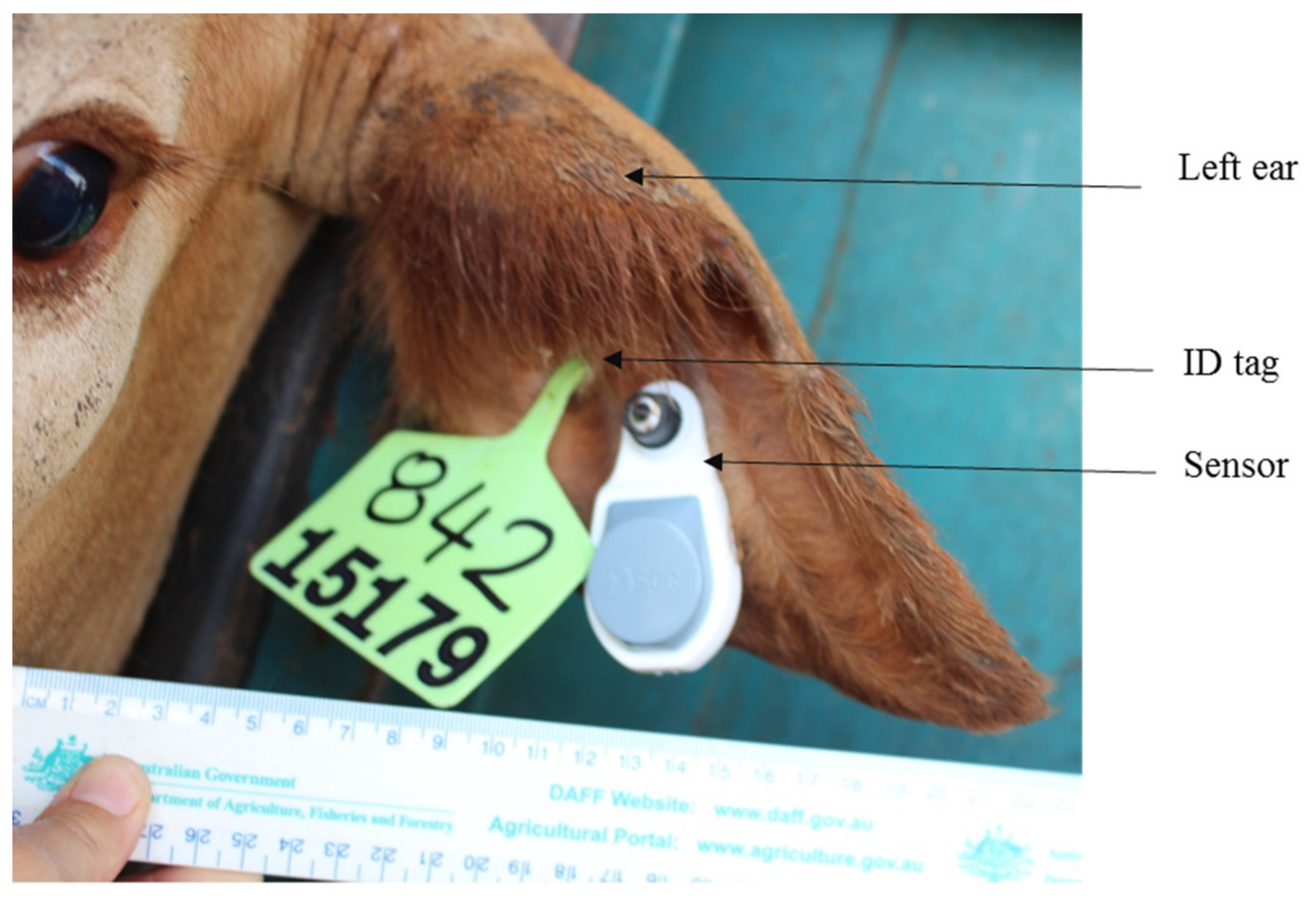
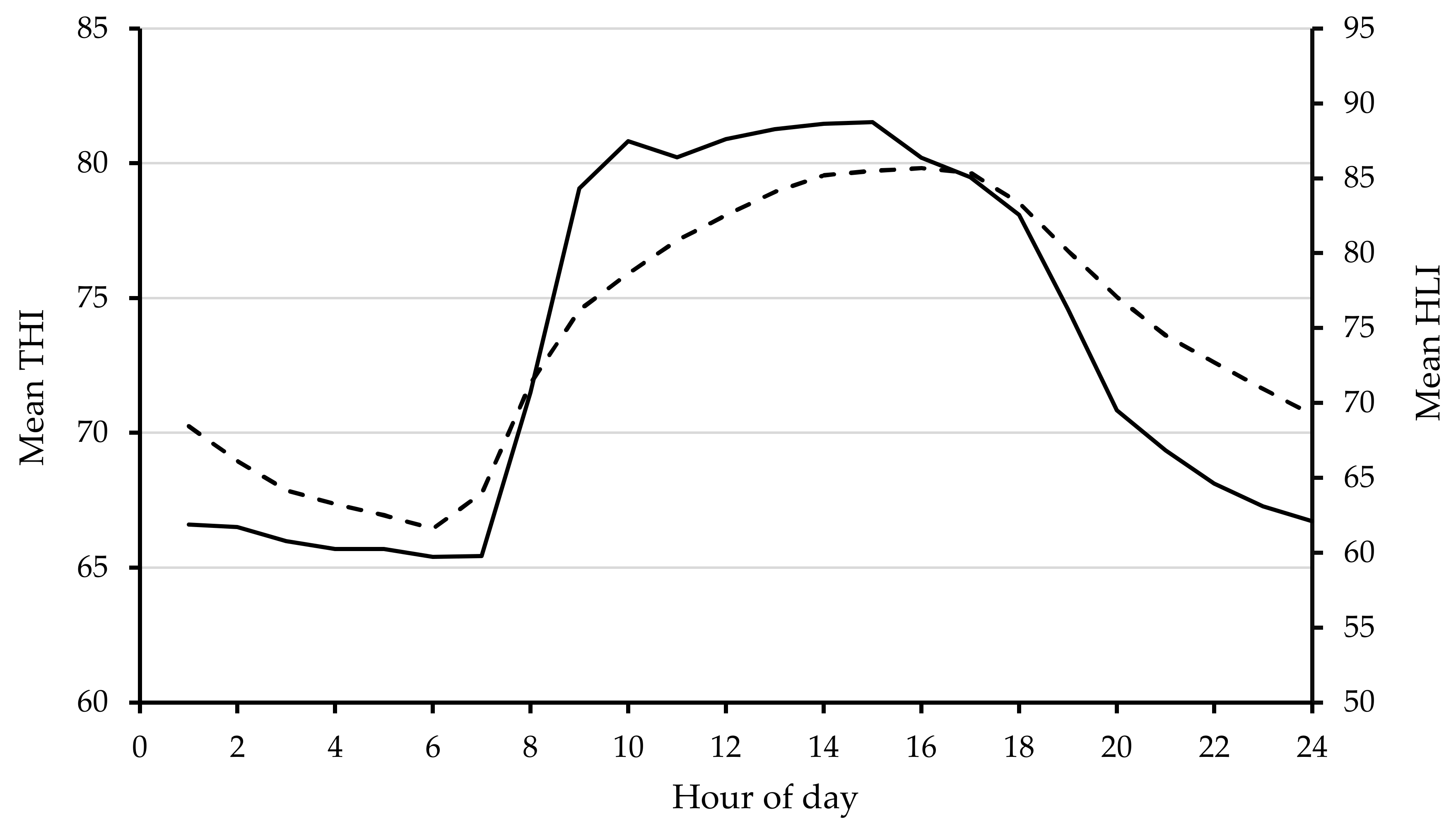
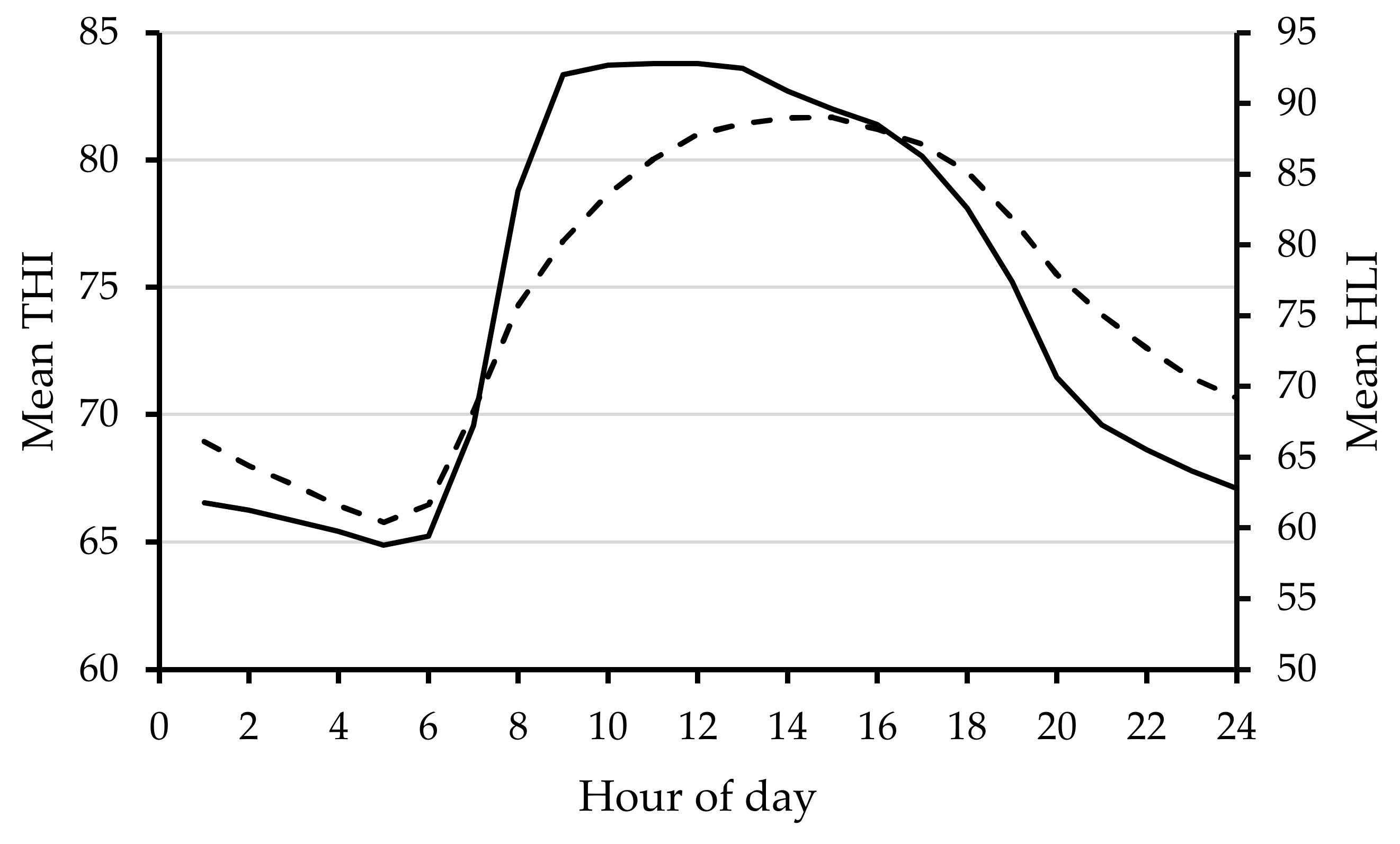
 ) and heat load index (HLI) (
) and heat load index (HLI) ( ) during Experiment 2. Shaded areas indicate selected heat event periods.
) during Experiment 2. Shaded areas indicate selected heat event periods.
 ) and heat load index (HLI) (
) and heat load index (HLI) ( ) during Experiment 2. Shaded areas indicate selected heat event periods.
) during Experiment 2. Shaded areas indicate selected heat event periods.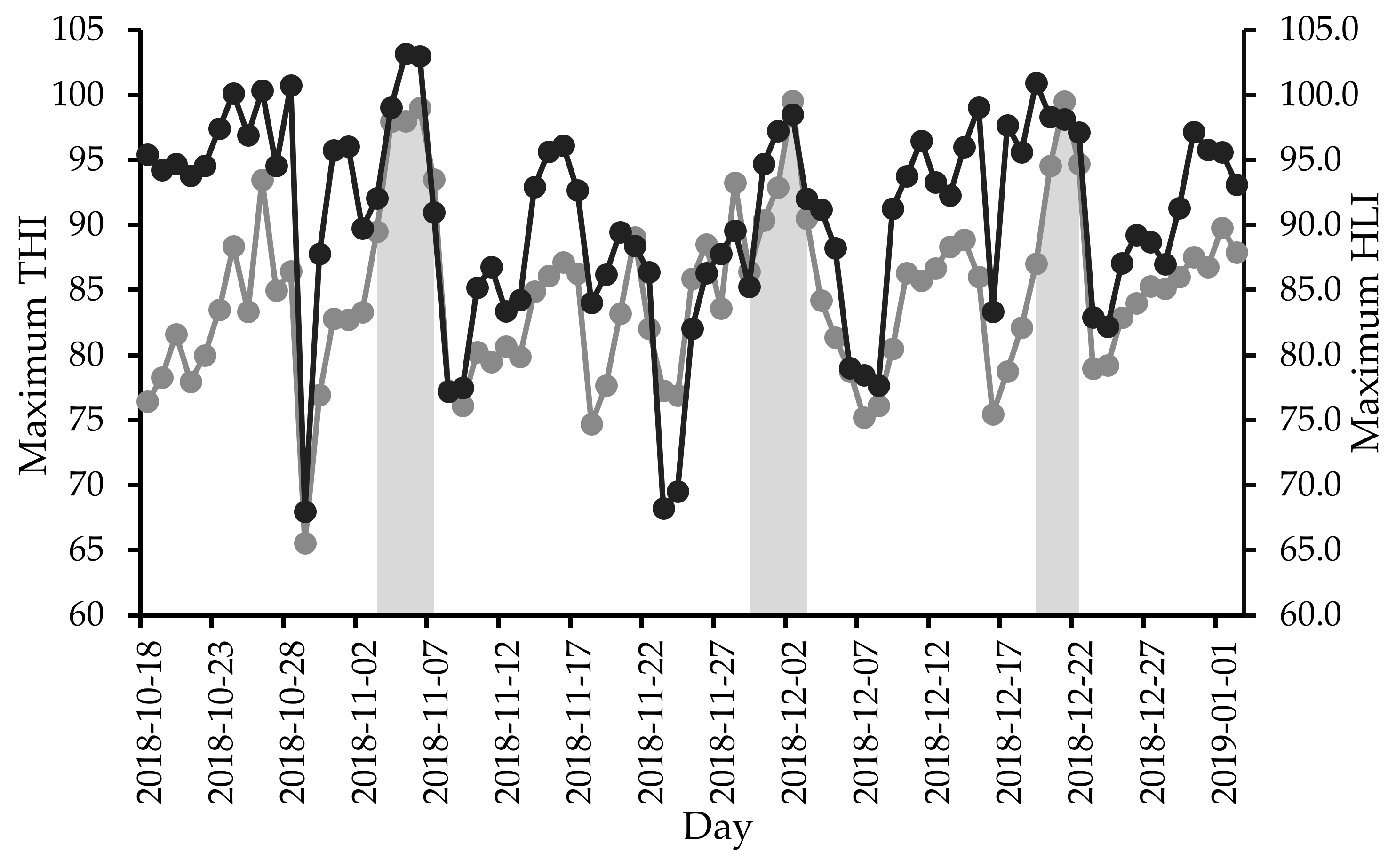
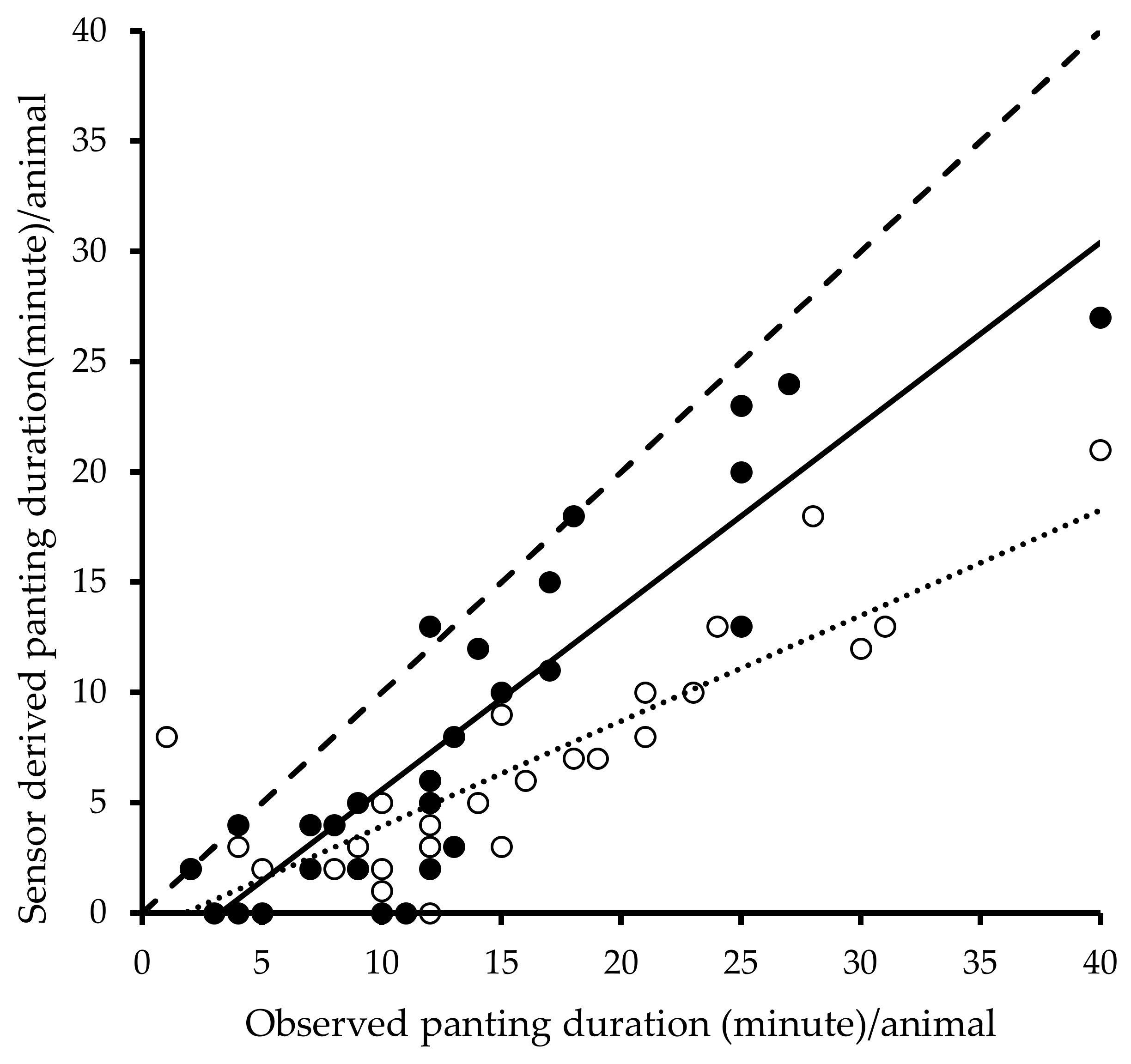
 ) and 50% Bos indicus (
) and 50% Bos indicus ( ) genotypes within the day. The error bar in the right hand top corner denotes average SED.
) genotypes within the day. The error bar in the right hand top corner denotes average SED.
 ) and 50% Bos indicus (
) and 50% Bos indicus ( ) genotypes within the day. The error bar in the right hand top corner denotes average SED.
) genotypes within the day. The error bar in the right hand top corner denotes average SED.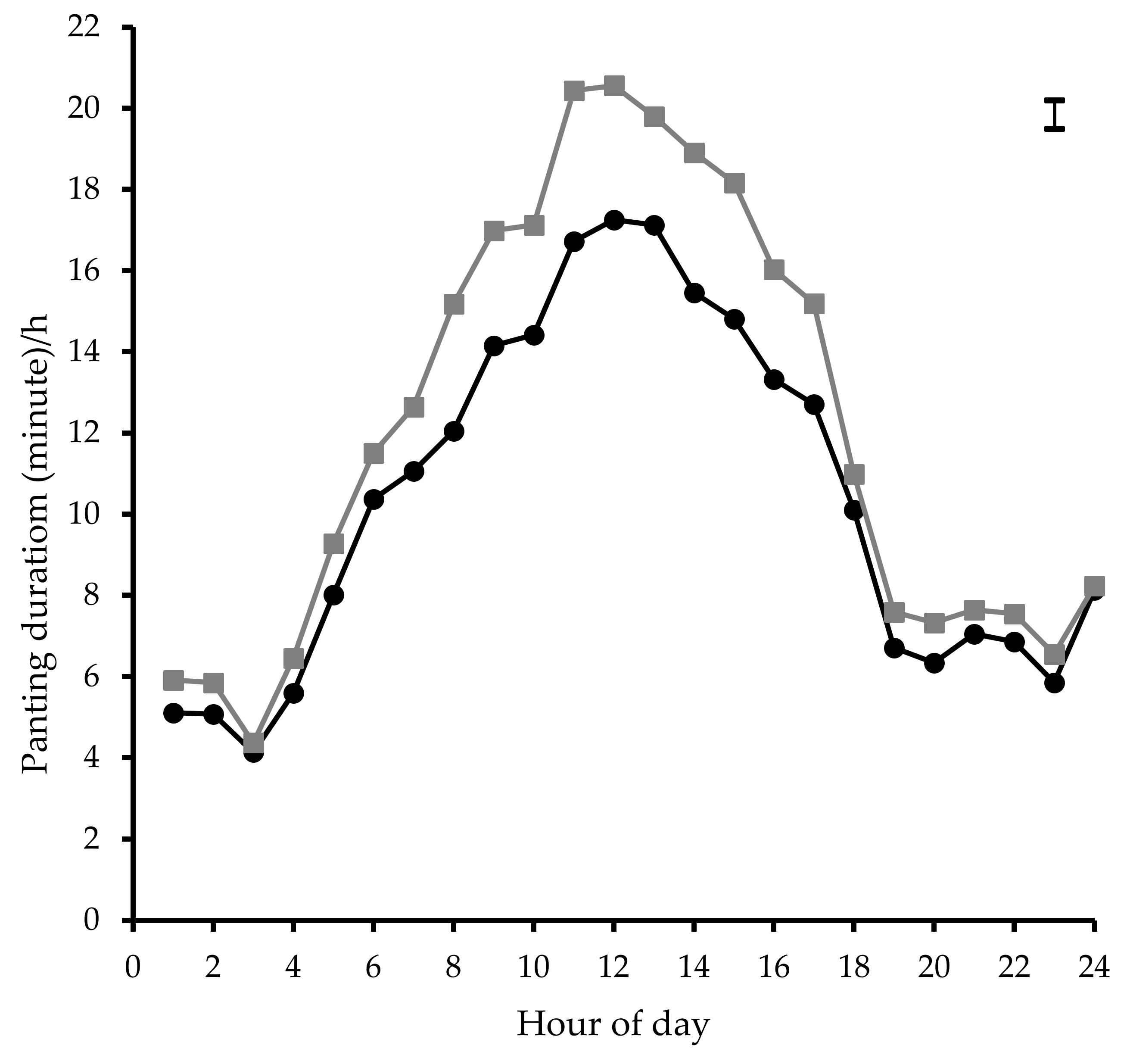
 ), tan (
), tan ( ), and white (
), and white ( ) coat colours within the day. The error bar in the right hand top corner denotes average SED.
) coat colours within the day. The error bar in the right hand top corner denotes average SED.
 ), tan (
), tan ( ), and white (
), and white ( ) coat colours within the day. The error bar in the right hand top corner denotes average SED.
) coat colours within the day. The error bar in the right hand top corner denotes average SED.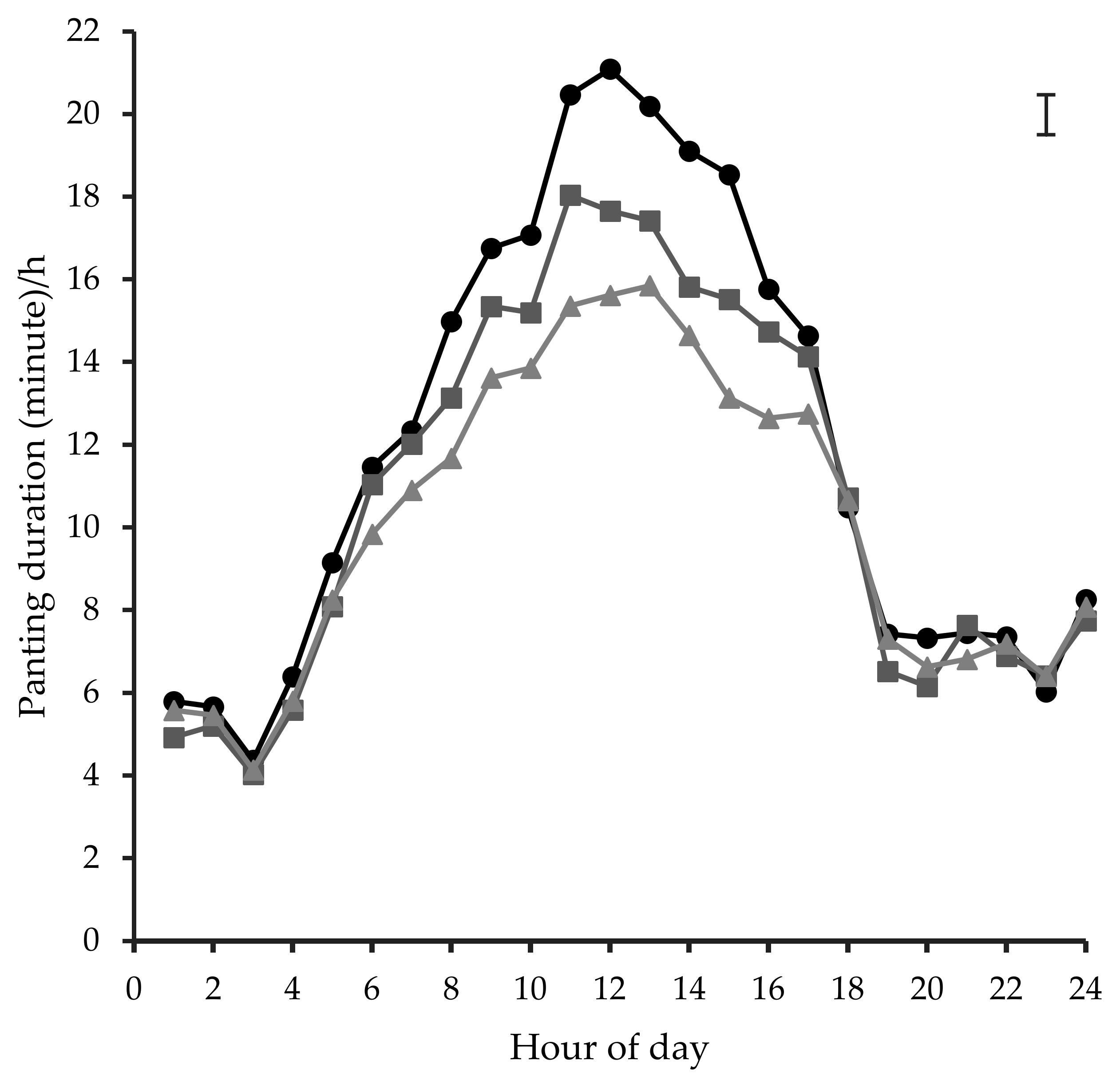
 ) and bottom (
) and bottom ( ) 10% cattle for panting within the same genotype ((A): 50% Bos indicus and (B): less than 40% Bos indicus) and coat colour ((C): Dark, (D): Tan and (E): White) categories in comparison to their herd mean panting duration/h (
) 10% cattle for panting within the same genotype ((A): 50% Bos indicus and (B): less than 40% Bos indicus) and coat colour ((C): Dark, (D): Tan and (E): White) categories in comparison to their herd mean panting duration/h ( ).
).
 ) and bottom (
) and bottom ( ) 10% cattle for panting within the same genotype ((A): 50% Bos indicus and (B): less than 40% Bos indicus) and coat colour ((C): Dark, (D): Tan and (E): White) categories in comparison to their herd mean panting duration/h (
) 10% cattle for panting within the same genotype ((A): 50% Bos indicus and (B): less than 40% Bos indicus) and coat colour ((C): Dark, (D): Tan and (E): White) categories in comparison to their herd mean panting duration/h ( ).
).
